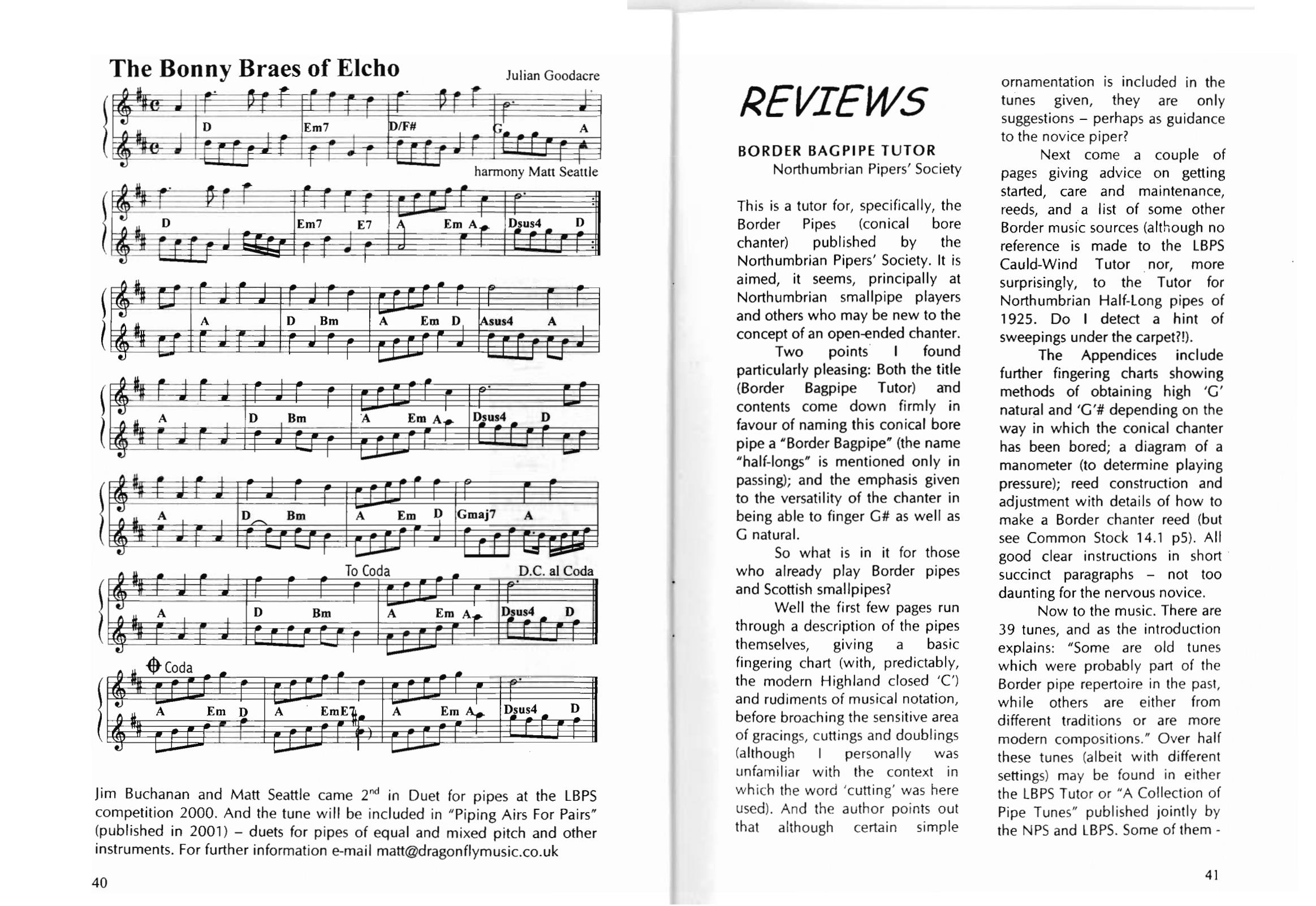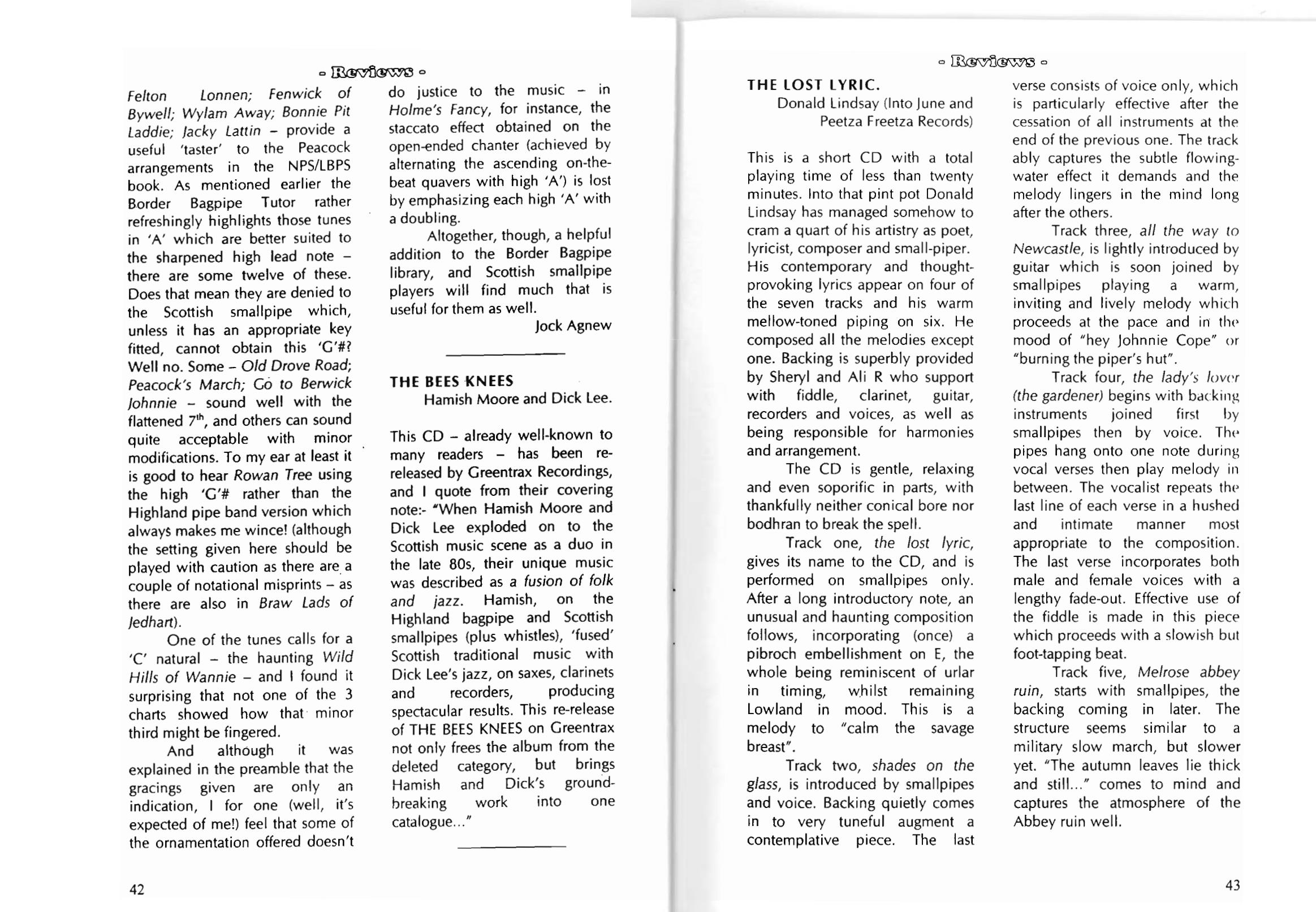Review: Book Border Bagpipe Tutor NPS


BORDER BAGPIPE TUTOR
Northumbrian Pipers' Society
This is a tutor for, specifically, the Border Pipes (conical bore chanter) published by the Northumbrian Pipers' Society. It is aimed, it seems, principally at Northumbrian smallpipe players and others who may be new to the concept of an open-ended chanter.
Two points I found particularly pleasing: Both the title (Border Bagpipe Tutor) and contents come down firmly in favour of naming this conical bore pipe a "Border Bagpipe" (the name "half-longs" is mentioned only in passing); and the emphasis given to the versatility of the chanter in being able to finger G# as well as G natural.
So what is in it for those who already play Border pipes and Scottish smallpipes?
Well the first few pages run through a description of the pipes themselves, giving a basic fingering chart (with, predictably, the modern Highland closed 'C') and rudiments of musical notation, before broaching the sensitive area of gracings, cuttings and doublings (although I personally was unfamiliar with the context in which the word 'cutting' was here used). And the author points out that although certain simple ornamentation is included in the tunes given, they are only suggestions - perhaps as guidance to the novice piper?
Next come a couple of pages giving advice on getting started, care and maintenance, reeds, and a list of some other Border music sources (although no reference is made to the LBPS Cauld-Wind Tutor nor, more surprisingly, to the Tutor for Northumbrian Half-Long pipes of 1925. Do I detect a hint of sweepings under the carpet?!).
The Appendices include further fingering charts showing methods of obtaining high 'G' natural and 'G'# depending on the way in which the conical chanter has been bored; a diagram of a manometer (to determine playing pressure); reed construction and adjustment with details of how to make a Border chanter reed (but see Common Stock 14.1 p5). All good clear instructions in short succinct paragraphs - not too daunting for the nervous novice.
Now to the music. There are 39 tunes, and as the introduction explains: "Some are old tunes which were probably part of the Border pipe repertoire in the past, while others are either from different traditions or are more modern compositions." Over half these tunes (albeit with different settings) may be found in either the LBPS Tutor or "A Collection of Pipe Tunes" published jointly by the NPS and LBPS. Some of them -
Felton Lonnen; Fenwick of Bywell; Wylam Away; Bonnie Pit Laddie; lacky Lattin - provide a useful 'taster' to the Peacock arrangements in the NPS/LBPS book. As mentioned earlier the Border Bagpipe Tutor rather refreshingly highlights those tunes in 'A' which are better suited to the sharpened high lead note - there are some twelve of these. Does that mean they are denied to the Scottish smallpipe which, unless it has an appropriate key fitted, cannot obtain this 'G'#? Well no. Some - Old Drove Road; Peacock's March; Co to Berwick Johnnie - sound well with the flattened 7lh, and others can sound quite acceptable with minor modifications. To my ear at least it is good to hear Rowan Tree using the high 'G'# rather than the Highland pipe band version which always makes me wince! (although the setting given here should be played with caution as there are a couple of notational misprints - as there are also in Braw Lads of ledhart).
One of the tunes calls for a 'C' natural - the haunting Wild Hills of Wannie - and I found it surprising that not one of the 3 charts showed how that minor third might be fingered.
And although it was explained in the preamble that the gracings given are only an indication, I for one (well, it's expected of me!) feel that some of the ornamentation offered doesn't do justice to the music - in Holme's Fancy, for instance, the staccato effect obtained on the open-ended chanter (achieved by alternating the ascending on-the- beat quavers with high 'A') is lost by emphasizing each high 'A' with a doubling.
